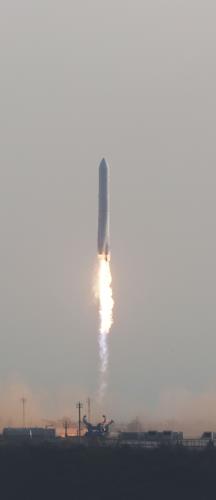ID :
513988
Wed, 11/28/2018 - 10:02
Auther :
Shortlink :
https://oananews.org//node/513988
The shortlink copeid
Space rocket engine burn time test meets target

GOHEUNG, South Korea, Nov. 28 (Yonhap) -- The engine burn time of South Korea's locally developed space rocket met its goal, the government said Wednesday.
The flight test of the 75-ton engine was conducted using a single-stage rocket that was launched from the Naro Space Center in Goheung, South Jeolla Province, at around 4:00 p.m.
The Ministry of Science and ICT said the test-launch vehicle engine maintained combustion for 151 seconds, exceeding the initial requirement of 140 seconds.
The rocket flew for about 10 minutes after reaching a maximum suborbital altitude of 209 kilometers. The exact location of where the rocket splashed down has yet to be announced.
The ministry expected the rocket to hit waters between the country's southern resort island of Jeju and Japan's southern island of Okinawa.
The rocket engine, designed and developed by the Korea Aerospace Research Institute Province (KARI), will be used on the three-stage Korea Space Launch Vehicle-2 (KSLV-2) currently under development.
The ministry and the KARI are scheduled to make an official announcement at 5:00 p.m.
"It is a meaningful development that South Korea has built a 75-ton thrust engine, indicating the country passed a threshold to develop its own space vehicle," a KARI official said.
The test launch was earlier suspended as abnormal readings were detected in the rocket propellant pressurization system.
The ministry had said the test will be deemed successful if engine combustion is maintained for set period of time during which the performance of the new engine, flight controls and other parts will be closely monitored.
If successful, four of the indigenous thrust engines will be grouped together on the first stage and one on the second stage of the KSLV-2, the ministry said. The whole rocket is scheduled to blast off in 2021.
The KSLV-2 rocket is to be South Korea's first space vehicle wholly designed and built in the country. It will be used to place unmanned satellites into the Earth's orbit and for other commercial applications.
So far, the country had relied on foreign launch vehicles for suborbital satellites. The successful launch of the KSLV-2 would open a new opportunity to enter the commercial space launch market.
khj@yna.co.kr
(END)





